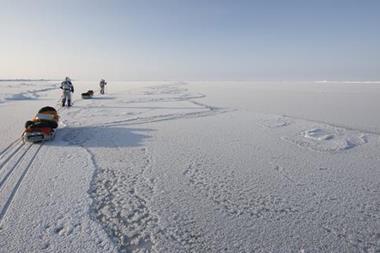Samples captured through “hole at the pole”
A team of three British explorers has collected samples from the North Pole to test CO2 absorption in the ocean.
The explorers reached the North Geographic Pole today (May 13) ending a gruelling 60 day scientific survey across the floating sea ice of the Arctic Ocean.
The Catlin Arctic Survey’s headquarters in London was contacted by team leader Ann Daniels and her colleagues Martin Hartley and Charlie Paton to say they had completed their survey work as they reached the Pole.
The team has been collecting water and marine life samples from beneath the floating sea ice as part of the expedition's programme to assess the impact of CO2 absorption on the ocean and its marine life – a process known as ocean acidification.
If global emissions of CO2 from human activities continue to rise on current trends there could be a three-fold increase in ocean acidity, according to the team. Since CO2 is more easily absorbed in cold waters, scientists believe the polar oceans will be the first to experience the impact and may become corrosive to the shells and armour-plating of some marine creatures within decades. This could not only threaten individual species, but also habitats and ecosystems, with potential impacts being felt beyond the oceans.
Their celebrations could not begin until they had taken the last samples through a hole drilled manually through the ice at the North Pole.
"We called it our Hole at the Pole" said Ann Daniels. "Getting the science work done has always been our top priority, but it is absolutely fantastic to reach the Pole as well. We’re ecstatic."
Speaking from Catlin Arctic Survey's headquarters in London, the Survey Director and explorer Pen Hadow described the team's achievement as extraordinary. "It's not possible to imagine what this team has had to do to pull off this extreme survey. I consider them to be the world’s toughest to have done this. Together they’re the face of modern exploration helping to advance the understanding of scientists and the public alike about how the natural world works. When, as a country, we are beset by so many challenges, these explorers are a window onto what is possible where there is a will. They make me proud to be British.”
The three explorers have travelled over 483 miles (777 kilometres) since March 14th but to reach the Pole have had to increase the amount of trekking time each day. They made it with only hours to spare before a Twin Otter plane was scheduled to land on the ice to collect them.
Commenting on the harsh conditions Ann Daniels said: "It has been an unbelievably hard journey over the ice. Conditions have been unusually tough and at times very frustrating with a frequent southerly drift pushing us backwards every time we camped for the night. On top of that we’ve had to battle into head-winds and swim across large areas of dangerously thin ice and open water."
The Catlin Arctic Survey 2010 is a unique collaboration between marine biologists, oceanographers and polar explorers to get vital science field work done which has not proved possible until now.
The expedition is sponsored by Catlin Group Limited, the international specialty insurer and reinsurer. Chief Executive Stephen Catlin said “It’s great news that the team has completed such an extensive survey and reached the North Pole. Their effort to obtain data that can help to forecast the risk posed by our changing environment is truly impressive.”
ABOUT THE EXPEDITION
The expedition's Ice Base was located off Ellef Ringnes Island
The Explorer Team set out on 14 March 2010
The Explorer Team travelled 483 miles (777 kilometres) in 60 days
An international group of scientists based in Europe, Canada and the USA will be able to use the results of the field studies.




















No comments yet